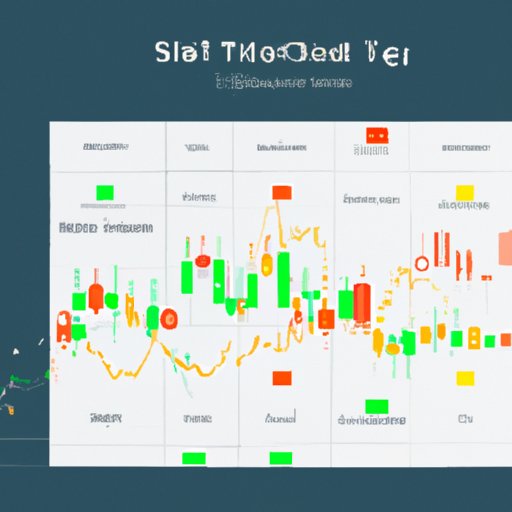Introduction
Cryptocurrency trading has become incredibly popular in recent years, as investors look to capitalize on the volatile nature of digital assets. One of the most popular forms of crypto trading is swing trading, which involves taking advantage of short-term price movements in order to generate profits. In this article, we will explore swing trading crypto in depth and provide you with the tools and knowledge you need to get started.
Definition of Swing Trading Crypto and Overview of Benefits and Risks
Swing trading crypto is an investment strategy that attempts to take advantage of short-term price movements in the cryptocurrency markets. Traders will typically buy into a coin when it’s at a low point and sell when it’s at a high point, resulting in profitable gains. Swing traders usually hold their positions for anywhere from a few hours to a few days, depending on the market conditions. This type of trading can be highly profitable, but it also carries a great deal of risk.
Identify Key Market Patterns
The key to successful swing trading is being able to identify market patterns. There are three main types of patterns that traders should be aware of: trend lines, support and resistance levels, and chart patterns. By studying these patterns and understanding how they work, you can gain insight into the direction of the markets and make more informed trades.
Trend Lines
Trend lines are used to identify the overall direction of the market. They are created by connecting two or more points on a chart, such as the highs and lows of a given period. If the trend line is sloping upwards, it indicates that the market is in an uptrend. Conversely, if the trend line is sloping downwards, it indicates that the market is in a downtrend.
Support and Resistance Levels
Support and resistance levels are points where the price of a coin is likely to find either support or resistance. For example, if the price of a coin bounces off of a certain level multiple times, it could indicate that there is strong support at that level. On the other hand, if the price of a coin is repeatedly rejected at a certain level, it could indicate that there is strong resistance at that level.
Chart Patterns
Chart patterns are formed by the price action of a coin over a period of time. Common chart patterns include head and shoulders, triangles, wedges, and flags. These patterns can provide insight into the direction of the market and help traders identify potential entry and exit points.
Analyze Technical Indicators
In addition to identifying key market patterns, traders should also analyze various technical indicators. These indicators can help traders determine the strength of a trend and identify potential entry and exit points. Popular technical indicators include moving averages, volume, and oscillators.
Moving Averages
Moving averages are used to measure the average price of a coin over a period of time. The most commonly used moving averages are the 50-day and 200-day moving averages. If the price of a coin is above its 50-day moving average, it could indicate that the market is in an uptrend. Conversely, if the price of a coin is below its 200-day moving average, it could indicate that the market is in a downtrend.
Volume
Volume is used to measure the amount of trading activity in the markets. If the volume of a coin is increasing, it could indicate that the trend is gaining momentum. Conversely, if the volume of a coin is decreasing, it could indicate that the trend is losing steam.
Oscillators
Oscillators are used to measure the momentum of a trend. Popular oscillators include the Relative Strength Index (RSI) and the Moving Average Convergence Divergence (MACD). If the RSI or MACD is indicating that the trend is overbought or oversold, it could be a sign that the trend is about to reverse.
Understand Risk Management
Risk management is an essential part of any trading strategy. It is important to understand the risks associated with trading and to manage them accordingly. Three key aspects of risk management include setting stop losses, position sizing, and diversifying across different coins.
Setting Stop Losses
A stop loss is a predetermined price at which a trader will close their position in order to limit their losses. Setting a stop loss can help protect against large losses and ensure that your trading capital remains safe.
Position Sizing
Position sizing is the process of determining how much capital to allocate to each trade. It is important to only invest an amount that you are comfortable with and to never risk more than you can afford to lose.
Diversifying Across Different Coins
Diversification is an important concept in trading. By diversifying across different coins, traders can reduce their overall risk and increase their chances of success.
Develop a Trading Plan
Once you have mastered the basics of swing trading crypto, it is time to develop a trading plan. This plan should include backtesting, paper trading, and tracking results. Backtesting involves testing a trading strategy on historical data to see if it would have been profitable in the past. Paper trading is the process of practicing a trading strategy without actually investing money. Finally, tracking results allows traders to monitor their performance and adjust their strategies accordingly.
Conclusion
Swing trading crypto can be a highly profitable venture, but it also carries a great deal of risk. It is important to understand the key market patterns, analyze technical indicators, understand risk management, and develop a trading plan. With the right knowledge and discipline, swing trading crypto can be an effective way to generate profits.
(Note: Is this article not meeting your expectations? Do you have knowledge or insights to share? Unlock new opportunities and expand your reach by joining our authors team. Click Registration to join us and share your expertise with our readers.)
